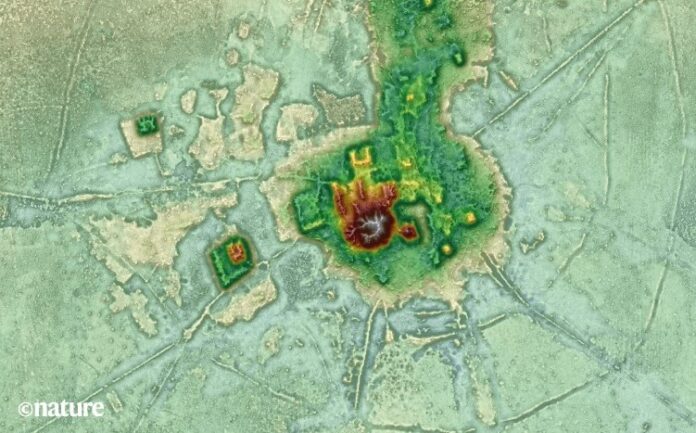The western part of the Amazon River basin some 1,500 years ago was home to a city-building culture that erected pyramids, elevated roadways and terraces across the riverine terrain.
It is no wonder that early Europeans searching for a city of gold in the Americas heard the folklore of indigenous people and may have attempted to find El Dorado but came up empty. All they would have discovered if they had stumbled on the site were forested mounds rising up from the watery landscape. The discovery marks the first indication of urban dwellings in the Amazon and the presence of a sophisticated and complex society.
Lidar uses lasers that provide a three-dimensional map of what lies beneath the surface when pointed downward. The technology used to map urban underground infrastructure is changing the study of archaeology and ancient civilizations in profound ways. It along with other modern imaging wizardry is helping to uncover the remains of the Mongol Empire and its capital city, Karakorum, on the Eurasian steppes. It has discovered numerous past settlements and buildings buried under tons of sediment.
In this latest discovery, a helicopter with lidar onboard flew over the trans-Andes regions of Bolivia which along with Peru is the area from where the headwaters of the Amazon River start. The lidar revealed a formerly hidden civilization containing 26 distinct settlements including 11 never previously suspected. Two of the urban settlements were three times larger than the Vatican City in Rome. Each contained walled compounds, gravesites, reservoirs, and terraces 6 metres above the surrounding area. In the centre of these terraces stood earthen conical pyramids 30 metres (100 feet) in the air. The people who built these settlements appear to have arisen around 500 AD (CE). They inhabited the settlements until around 1400. The culture is called the Casarabe people.
Why would there be a need for reservoirs in these cities? Considering the current abundance of water on-site, the need for water storage back then indicates much drier conditions. Residual pollens in soil samples show that at one time the area was under cultivation for a very long period with corn (maize) the predominant crop. Corn needs much drier conditions than can be found in that area of the Amazon basin today.
Finding the settlements of the Casarabe may not be a unique experience. It is likely that archeological treasures pointing to past civilizations are still to be uncovered and a renewed interest in the history of the people who lived in the Amazon Basin may yet help to preserve much of it.
Why is this so important? Because there is no other place on Earth that resembles the Amazon River. Its closest match is the Congo River in Africa, but it is puny in comparison. The Amazon is 6,400 kilometres (over 4,000 miles) in length from its headwaters to the mouth. This is a distance equal to travelling from New York City to Rome. The source lies high in the Andes and a mere 160 kilometres (100 miles) from the Pacific Ocean. The Amazon Basin covers 7 million square kilometres (2.7 million square miles) almost the size of the 48 lower states of the US.
Approximately 20% of all the fresh water on our planet is contained within it. The discharge from its mouth (1.3 million tons of sediment daily) is ten times greater than that that flows from the Mississippi. The current is so powerful that the neighbouring Atlantic remains largely fresh as much as 160 kilometres (100 miles) from its mouth.
Today the Amazon Basin resembles a giant floodplain with a gradient so slight it varies by a mere 90 metres (300 feet) from the Peruvian border on the edge of the Andes foothills to the mouth of the river. The area is densely covered by the world’s largest tropical rainforest. On its margins and at higher elevations can be found climate conditions quite different, supporting dry tropical forests and savanna (more like what the Casarabe environment was like).
The Casarabe’s earthen structures would never survive today’s wet Amazon environment. The climate between 500 and 1400 points to something far different. And going further back there is even more evidence of climate change. For example, between 2.6 and 5.3 million years, what today is the river basin was once a gigantic freshwater lake bigger than any on the planet today. A change in the climate 2.6 million years ago pushed the planet into the Pleistocene (Ice Age) which caused sea levels to drop as a great deal of water became bound in ice, including enormous glaciers in the Andes. Eventually, drainage from the mountains raised water levels in the inland lake to a point where it spilled over forming a link to the Atlantic Ocean. Today’s Amazon, is a pale reflection of that lake, a landscape containing a series of valleys lying under thousands of metres of sediment accumulated from Andean ice field meltwater that continues to feed it.
The Amazon represents a dynamic changing world that has undergone enormous alterations over its existence in geological time. And once, where a civilization existed of cities and settlements rising above fertile fields, is now the Casarabe’s watery grave.
What natural climate has done to the area over time is now being accelerated by our modern human presence which is changing the river’s history once again as we accelerate the destruction of tens of thousands of hectares of rainforest annually. It is hoped that a growing interest in the archaeology being discovered in the Amazon, driven by lidar, may yet preserve what remains of the Amazon’s natural state, that is, if we can get global warming under control.
















